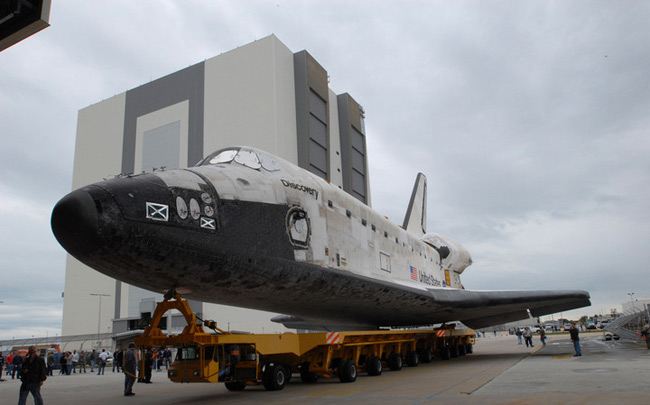Astronauts Primed for Space Station Power Boost

WASHINGTON- Seven astronauts are gearing up to launch toward the International Space Station next month to deliver a final pieceof the outpost?s power grid, the last major American-built addition to theorbiting laboratory.
The spaceflyers are slatedto lift off aboard the space shuttle Discovery on Feb. 12 from NASA?s Kennedy Space Center in Cape Canaveral,Fla., to deliver the last starboard piece of the space station?s metallicbackbone-like truss and unfurl a pair of expansive U.S. solar wings from itstip.
The newaddition is the fourth set of U.S. solar arrays to feed the station?selectrical grid and will give the orbital laboratory a wingspan that will rivalan American football field in length once attached. The starboard-side wingswill also make the station an even brighter target for skywatchers on Earthhoping to glimpse the outpost?s path across the night sky.
?It?s thestart, for us, to a very exciting year,? NASA shuttle program manager JohnShannon told reporters on Friday.
Commandedby veteran spaceflyer Lee Archambault, Discovery?s STS-119 mission is NASA?sfirst of up to six planned shuttle flights for 2009. They include one finalflight to overhaulthe Hubble Space Telescope and a series of space station constructionmissions.
?We?re ofcourse very proud to be on this mission.? said Archambault, who added that hehelped give the space station a symmetrical look during his first spaceflightin 2007, which also delivered new solar wings. ?Since then NASA has unbalancedit, so we?re getting a chance to balance it again.?
Fourspacewalks are planned to install the 32,000-pound (14,514-kg) starboard-sidesolar arrays and upgrade the station?s exterior during Discovery?s flight.
Breaking space news, the latest updates on rocket launches, skywatching events and more!
Threespaceflight rookies and four veterans make up Archambault?s crew. The crewincludes teachers-turned-astronauts Joseph Acaba and Richard Arnold II, as wellveteran astronaut Koichi Wakata, a two-time spaceflyer for the Japan AerospaceExploration Agency who will become Japan?s first long-duration astronaut whenhe joins the space station?s Expedition 18 crew during Discovery?s two-weekmission.
Wakatahelped install the first section of the space station?s 11-segment main trussback in 2000 during his last spaceflight. Now he?ll help attach its finalpiece, then stay aboard to take charge of the outpost?s Japanese Kibolaboratory.
Discoverymay also carry a spare part of the space station?s new water recycling system,an intricate - andsometimes icky - assembly that filters astronaut wastewater, sweat andurine back into drinking water.
Astronautsinstalled the recycling system aboard the station last November despiteglitches with a balkyurine distillation component. That component failed again just beforeChristmas. Engineers and astronauts are trying to revive the device, but wouldneed the spare from Earth if they fail, said NASA's space station program manager Mike Suffredini.
The urinerecycler is part of a $250 million life support system that must work if thespace station is to sustain larger, six-person crews for the long-term.
Suffredinisaid he is confident that engineers will overcome the urine recycler?s glitchesand have a spare ready in time if required. Even if the unit is not operationalby May, the space station can still support the jump to six-person crews withthe help water shipments aboard NASA shuttles this year, he added.
2009 isexpected to bring the space station to the brink of completion. In addition toDiscovery?s February flight and the planned Hubble Space Telescope flight inmid-May, NASA space shuttles are expected to deliver the final segment ofJapan?s Kibo laboratory this summer, a vital batch of spare parts and suppliesand a new connecting node and viewport.
?Last yearwas a banner year for the station and a huge success,? Suffredini said. ?Thisyear will be no less exciting.?
- Video - Space Shuttle Bloopers!
- Images - Stunning Night Launch for Shuttle Endeavour
- Video - Drinking Water From Space Urine

Tariq is the award-winning Editor-in-Chief of Space.com and joined the team in 2001. He covers human spaceflight, as well as skywatching and entertainment. He became Space.com's Editor-in-Chief in 2019. Before joining Space.com, Tariq was a staff reporter for The Los Angeles Times covering education and city beats in La Habra, Fullerton and Huntington Beach. He's a recipient of the 2022 Harry Kolcum Award for excellence in space reporting and the 2025 Space Pioneer Award from the National Space Society. He is an Eagle Scout and Space Camp alum with journalism degrees from the USC and NYU. You can find Tariq at Space.com and as the co-host to the This Week In Space podcast on the TWiT network. To see his latest project, you can follow Tariq on Twitter @tariqjmalik.
